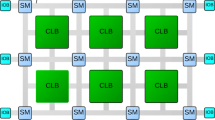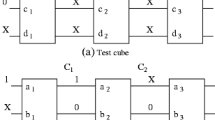Abstract
This paper presents a new effective Built-In Self Test (BIST) scheme that achieves 100% fault coverage with low area overhead, and without any modification of the circuit under test (CUT), i.e., no test point insertion. The set of patterns generated by a pseudo-random pattern generator, e.g. a Linear Feedback Shift Register (LFSR), is transformed into a new set of patterns that provides the desired fault coverage. To transform these patterns, a ring architecture composed by a set of masks is used. During on-chip test pattern generation, each mask is successively selected to map the original pattern sequence into a new test sequence. We describe an efficient algorithm that constructs a ring of masks from the test cubes provided by an automatic test pattern generator (ATPG) tool. Moreover, we show that rings of masks are implemented very easily at low silicon area cost, without requiring any logic synthesis tool; a combinational mapping logic corresponding to the masks is placed between the LFSR and the CUT, together with a looped shift register that acts as a mask selecting circuit. Experimental results are given at the end of the paper, demonstrating the effectiveness of the proposed approach in terms of area overhead, fault coverage and test sequence length. Note that this paper is an extended version of [1].
Similar content being viewed by others
References
C. Fagot, O. Gascuel, P. Girard, and C. Landrault, “A Ring Architecture Strategy for BIST Test Pattern Generation,” IEEE Asian Test Symposium, pp. 418-423, 1998.
Y. Zorian, “Testing the Monster Chip,” IEEE Spectrum, pp. 54-60, July 1999.
Semiconductor Industry Association (SIA), International Technology Roadmap for Semiconductors (ITRS), 1999 edition.
E.B. Eichelberger and E. Lindbloom, “Random-Pattern Coverage Enhancement and Diagnosis for LSSD Logic Self-Test,” IBM Journal of Research and Development, vol. 27, no. 3, pp. 265-272, 1983.
J.P. Hayes and A.D. Friedman, “Test Point Placement to Simplify Fault Detection,” IEEE Trans. on Computers, vol. C-33, pp. 727-735, July 1974.
N. Tamarapalli and J. Rajski, “Constructive Multi-Phase Test Point Insertion for Scan-Based BIST,” in IEEE International Test Conference, 1996, pp. 649-658.
G. Hetherington, T. Fryars, N. Tamarapalli, M. Kassab, A. Hassan, and J. Rajski, “Logic BIST for Large Industrial Designs: Real Issues and Case Studies,” in IEEE International Test Conference, 1999, pp. 358-367.
R.W. Bassett et al., “Low Cost Testing of High Density Logic Components,” in IEEE International Test Conference, 1989, pp. 550-557.
H.J. Wunderlich, “Self Test Using Unequiprobable Random Patterns,” in IEEE International Symposium on Fault-Tolerant Computing, 1987, pp. 258-263.
F. Brglez et al., “Hardware-Based Weighted Random Pattern Generation for Boundary-Scan,” in IEEE International Test Conference, 1989, pp. 264-274.
S. Hellebrand, H.J. Wunderlich, and O.F. Haberl, “Generating Pseudo-Exhaustive Vectors for External Testing,” in IEEE International Test Conference, 1990, pp. 670-679.
B. Koenemann, “LFSR-Coded Test Patterns for Scan Designs,” IEEE European Test Conference, 1991, pp. 237-242.
S. Hellebrand, S. Tarnick, J. Rajski, and B. Courtois, “Generation of Vector Patterns Through Reseeding of Multiple-Polynomial Linear Feedback Shift Registers,” in IEEE International Test Conference, 1992, pp. 120-129.
G. Edirisooriya and J.P. Robinson, “Design of Low Cost ROM Based Test Generators,” in IEEE VLSI Test Symposium, 1992, pp. 61-66.
C. Dufaza, H. Viallon, and C. Chevalier, “BIST Hardware Generator for Mixed Testing Scheme,” in IEEE European Design & Test Conference, 1995, pp. 424-430.
D. Kangaris and S. Tragoudas, “Generating Deterministic Unordered Test Patterns with Counter,” in IEEE VLSI Test Symposium, 1996, pp. 374-379.
M. Chatterjee and D.K. Pradhan, “A Novel Pattern Generator for Near-Perfect Fault Coverage,” in IEEE VLSI Test Symposium, 1995, pp. 417-425.
N.A. Touba and E.J. McCluskey, “Synthesis of Mapping Logic for Generating Transformed Pseudo-Random Patterns for BIST,” in IEEE International Test Conference, 1995, pp. 674-682.
S. Hellebrand, B. Reeb, S. Tarnick, and H.J. Wunderlich, “Pattern Generation for a Deterministic BIST Scheme,” in IEEE International Conference on Computer-Aided Design, 1995, pp. 88-94.
N.A. Touba and E.J. McCluskey, “Altering a Pseudo-Random Bit Sequence for Scan-Based BIST,” in IEEE International Test Conference, 1996, pp. 167-175.
H.J. Wunderlich and G. Kiefer, “Bit-Flipping BIST,” in IEEE International Conference on Computer-Aided Design, 1996, pp. 337-343.
C. Fagot, P. Girard, and C. Landrault, “On Using Machine Learning for Logic BIST,” in IEEE International Test Conference, 1997, pp. 338-346.
G. Kiefer and H.J. Wunderlich, “Deterministic BIST with Multiple Scan Chains,” in IEEE International Test Conference, 1998, pp. 1057-1064.
G. Kiefer and H.J. Wunderlich, “Deterministic BIST with Partial Scan,” IEEE European Test Workshop, pp. 110-116, 1999.
G. Kiefer, H. Vranken, E.J. Marinissen, and H.J. Wunderlich, “Application of Deterministic Logic BIST on Industrials Circuits,” in IEEE International Test Conference, 2000, pp. 105-114.
C. Fagot, O. Gascuel, P. Girard, and C. Landrault, “On Calculating Efficient LFSR Seeds for Built-In Self Test,” IEEE European Test Workshop, pp. 7-14, 1999.
F. Brglez and H. Fujiwara, “A Neutral Netlist of 10 Combinational Benchmark Circuits and a Target Translator in Fortran,” in IEEE International Symposium on Circuits and Systems, 1985, pp. 663-698.
F. Brglez, D. Bryant, and K. Kozminski, “Combinational Profiles of Sequential Benchmark Circuits,” in IEEE International Symposium on Circuits and Systems, 1989, pp. 1929-1934.
M. Abramovici, P.R. Menon, and D.T. Miller, “Critical Path Tracing: An Alternative to Fault Simulation,” in IEEE Design & Test of Computers, vol. 1, no. 1, Feb. 1984.
TestGen, version Tg4.1, User Guide, Synopsys Inc., 1999.
S. Wang, “Low Hardware Overhead Scan Based 3-Weight Weighted Random BIST,” in IEEE International Test Conference, 2001, pp. 868-877.
Author information
Authors and Affiliations
Rights and permissions
About this article
Cite this article
Fagot, C., Gascuel, O., Girard, P. et al. A Ring Architecture Strategy for BIST Test Pattern Generation. Journal of Electronic Testing 19, 223–231 (2003). https://doi.org/10.1023/A:1023788727542
Issue Date:
DOI: https://doi.org/10.1023/A:1023788727542




